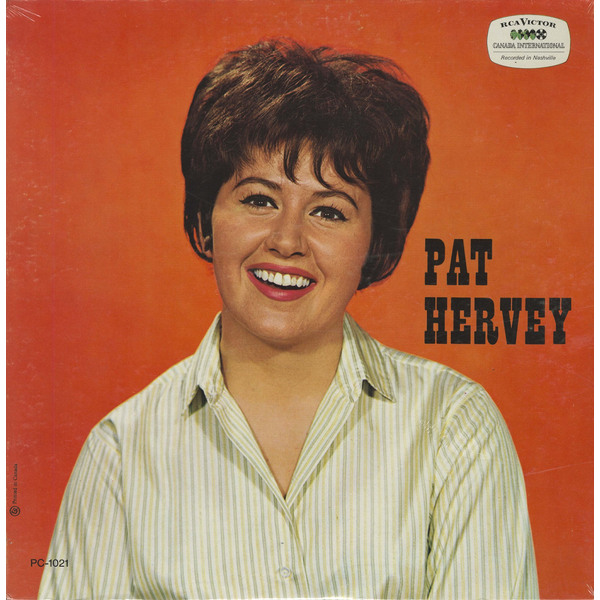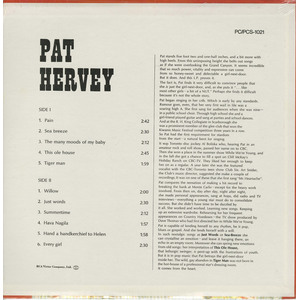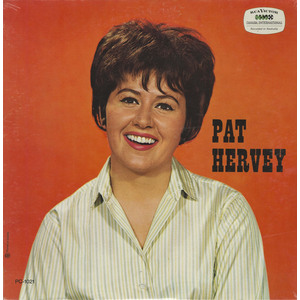Information/Write-up
Pat Hervey: Canada's Little Giant of Song
Born in Toronto on February 20, 1943, Pat Hervey grew up small in stature but big in voice. A natural performer from the time she could talk, Pat first honed her singing talents imitating her mother around the house, and soon after by mimicking the popular records spinning on the family turntable.
By the time she was eight years old, Pat was singing publicly at school and church events while attending Eglinton Avenue Public School. Her musical instincts only sharpened through her teenage years at R.H. King Collegiate in Scarborough, where she and a friend formed a guitar-driven duo inspired by the close harmonies of the Everly Brothers. Their act quickly became a local favorite at dances and parties, catching the ear of Toronto radio personality Al Boliska. So impressed with Pat’s voice, Boliska offered to manage her solo career. Though initially hesitant to leave her musical partner behind, Pat soon realized the opportunity in front of her.
At just sixteen, Pat Hervey made her leap to professional stardom, landing regular appearances on CBC Television. Her lively performances could be seen on national programs such as Club Six, Music Hop, Holiday Ranch, Country Hoedown, and While We’re Young. Quickly, she became a familiar face to Canadian audiences coast-to-coast.
Behind the scenes, Art Snider, musical director for Club Six and founder of Chateau Records, recognized Pat’s potential. He arranged for her to travel to Nashville to record with the legendary Chet Atkins in 1962. Her debut single, Lonesome Trail backed with Stormy Weather, introduced her to Canadian airwaves, but it was the follow-up, Mister Heartache, that launched her into national fame. Written by Les Shea (under the pen name Les Pouliot), Mister Heartache climbed the charts across Canada — cracking the Top 10 in multiple cities and staying on Toronto’s CHUM chart for twelve weeks.
Building on this momentum, Pat signed with RCA Victor later that year, thanks again to Chet Atkins’ mentorship. Throughout 1963, she released a string of singles that showcased her maturity as a vocalist, including Tears of Misery, Brother Can You Spare a Dime?, and It’s Love That Counts. Her records resonated especially well in Canadian markets, even as the British Invasion was beginning to crowd out homegrown artists.
Despite fierce competition from across the Atlantic, Pat held her own. In 1964, she joined fellow Canadians The Allan Sisters on a groundbreaking trip to England, where they became among the first Canadian vocalists to record in the U.K. Twelve tracks were cut during the session — six each by the Allan Sisters and Pat. While Mr. Special / Wherever You Are became a notable hit for the Allan Sisters, Pat continued to chart with her own ACT-label singles including Think About Me and I’ll Count Every Hour, the latter becoming a major hit on the country charts.
Her style spanned pop, country, and early soul, a reflection of her television background where versatility was key. This breadth culminated in the release of her first full-length album in 1965, recorded once again with Chet Atkins and top Nashville session players. Although critically praised, the album struggled commercially in a market increasingly dominated by rock bands and changing trends.
As the 1960s wore on, Pat’s recordings continued, first for Red Leaf Records and later through a U.K. deal with President Records. Singles like Can't Get You Out of My Mind reflected a slightly edgier, more pop-soul direction, but Canadian radio was shifting fast, and sustaining momentum became harder.
By the end of the decade, Pat stepped back from the national spotlight. She relocated to Vancouver in early 1969, seeking a quieter life and a fresh start. However, music remained an integral part of her identity. In 1970, CBC gave her a starring role in her own summer variety series and invited her back into the studio for a 1971 covers album, where she delivered elegant renditions of songs like Scarborough Fair and Any Day Now.
Further recordings for the CBC’s LM series followed, resulting in a handful of rare singles and an EP featuring interpretations of contemporary hits like Killing Me Softly and Summer Breeze. Though these releases were limited mainly to radio station libraries, they showcased Pat’s enduring ability to adapt to new sounds with grace and emotional depth.
Throughout the 1970s, Pat settled into a more local performing life, singing jazz in Vancouver clubs alongside her husband, renowned guitarist Oliver Gannon. Together, they formed the Oliver Gannon/Patty Hervey Quartet, where she traded the pop charts for intimate stages, performing sophisticated jazz and standards with flair.
Pat Hervey’s career left a lasting imprint on Canadian music history. She was among the first wave of Canadian female pop singers to achieve national success, a trailblazer whose youthful energy matured into a lifetime of musical excellence. Though her commercial recordings remain underappreciated today, Pat Hervey’s story — from teenage television star to seasoned jazz vocalist — is one of passion, perseverance, and undeniable talent.
-Robert Williston
Museum of Canadian Music Musée de la Musique Canadienne Calgary Vinyl Music Museum Canada Museum of Recorded Sound Canada Music Museum Calgary Music Museum



Highly recommend listening to the pretty ballad Sea Breeze on this album. Pat Hervey's rendition of the soul song Pain has attracted a lot of interest. Willow is a catchy number that highlights Pat's strong, expressive voice and country music listeners will enjoy Just Words.